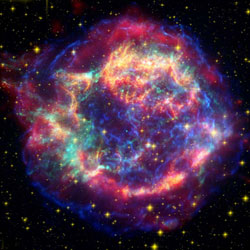
Supernova remnant Cassiopeia A. Image credit: NASA/JPL. Click to enlarge.
An enormous light echo etched in the sky by a fitful dead star was spotted by the infrared eyes of NASA’s Spitzer Space Telescope.
The surprising finding indicates Cassiopeia A, the remnant of a star that died in a supernova explosion 325 years ago, is not resting peacefully. Instead, this dead star likely shot out at least one burst of energy as recently as 50 years ago.
“We had thought the stellar remains inside Cassiopeia A were just fading away,” said Dr. Oliver Krause, University of Arizona, Tucson. “Spitzer came along and showed us this exploded star, one of the most intensively studied objects in the sky, is still undergoing death throes before heading to its final grave.”
Infrared echoes trace the dusty journeys of light waves blasted away from supernova or erupting stars. As the light waves move outward, they heat up clumps of surrounding dust, causing them to glow in infrared light. The echo from Cassiopeia A is the first witnessed around a long-dead star and the largest ever seen. It was discovered by accident during a Spitzer instrument test.
“We had no idea that Spitzer would ever see light echoes,” said Dr. George Rieke of the University of Arizona. “Sometimes you just trip over the biggest discoveries.”
To view the echoes dancing through clouds of dust surrounding Cassiopeia A, visit:
http://www.spitzer.caltech.edu/Media/releases/ssc2005-14/visuals.shtml.
A supernova remnant like Cassiopeia A typically consists of an outer, shimmering shell of expelled material and a core skeleton of a once-massive star, called a neutron star. Neutron stars come in several varieties, ranging from intensely active to silent. Typically, a star that has recently died will continue to act up. Consequently, astronomers were puzzled that the star responsible for Cassiopeia A appeared to be silent so soon after its death.
The new infrared echo indicates the Cassiopeia A neutron star is active and may even be an exotic, spastic type of object called a magnetar. Magnetars are like screaming dead stars, with eruptive surfaces that rupture and quake, pouring out tremendous amounts of high-energy gamma rays. Spitzer may have captured the “shriek” of such a star in the form of light zipping away through space and heating up its surroundings.
“Magnetars are very rare and hard to study, especially if they are no longer associated with their place of origin. If we have indeed uncovered one, then it will be just about the only one for which we know what kind of star it came from and when,” Rieke said.
Astronomers first saw hints of the infrared echo in strange, tangled dust features that showed up in the Spitzer test image. When they looked at the same dust features again a few months later using ground-based telescopes, the dust appeared to be moving outward at the speed of light. Follow-up Spitzer observations taken one year later revealed the dust was not moving, but was being lit up by passing light.
A close inspection of the Spitzer pictures revealed a blend of at least two light echoes around Cassiopeia A, one from its supernova explosion, and one from the hiccup of activity that occurred around 1953. Additional Spitzer observations of these light echoes may help pin down their enigmatic source.
Krause was lead author with Rieke of a study about the discovery appearing this week in the journal Science.
JPL manages the Spitzer Space Telescope mission for NASA’s Science Mission Directorate. Science operations are conducted at the Spitzer Science Center, California Institute of Technology, Pasadena, Calif. JPL is a division of Caltech. Spitzer’s multiband imaging photometer, which made the new observations, was built by Ball Aerospace Corporation, Boulder, Colo.; the University of Arizona; and Boeing North America, Canoga Park, Calif. Its development was led by Rieke.
For additional images and information about Spitzer on the Web, visit: http://www.spitzer.caltech.edu/Media. For information about NASA and agency programs on the Web, visit: http://www.nasa.gov/home/index.html.
Original Source: NASA/JPL News Release
